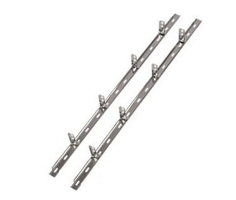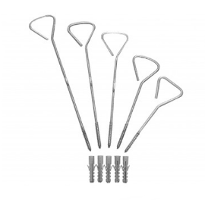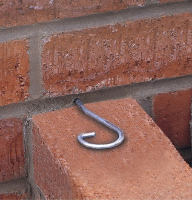How To Tie A New Wall To An Existing Brickwork

How To Tie A New Wall To An Existing Brickwork
When you are planning to build a new extension to your home, or additional wall to your garden wall, you come up against the problem of how to tie the new wall to the existing wall. Traditionally this was done by method called toothing out. This means removing alternate bricks or blocks to leave a tooth like shape, to which the new wall is tied. This process is time consuming and labour extensive, therefore more costly than the modern tying methods.
There is a wall tie method that is so simple it takes all of the hard work out of tooth brickwork to tie existing brickwork these days. The wall starters are much easier and quicker to mount, reducing construction time and therefore the cost. It also eliminates the problem of achieving adequate mortar bond at the toothed connection. The other method is to use stainless steel screw-in ties.
The wall starter connector is simply bolted to the existing wall and wall ties are then slotted into the rack at distances, where it is required to tie into the new wall. These connectors are bolted to the wall in a plumb upright position to ensure any brickwork is also straight and level. The bond is just as strong as the traditional toothing out method, but saves construction time. The wall starter kits are made from either austhenitic stainless steel or ferritic stainless steel. You can use them to connect walls up to 8m in height (3 stories) and wall thickness from 60mm to 250mm.

- External walls,
- Internal walls,
- Cavity walls (each leaf must have a separate wall starter)
Installation method
- Plumb the lower connector against the existing wall so that it will be central to the new wall,
- Mark the position of the fixing holes.
- Each connector should be fixed at three points, the first and last slot and in the centre.
- Ensure that one fixing is at the point where the two connectors slot together and overlap.
- Fixings should be into brickwork and not mortar joints.
- Drill and plug using an 8mm masonry drill bit.
- Fix the bottom two holes lightly using the stainless steel coach screws and washers.
- Slot the upper connector into the lower one and repeat the above stages.
- The upper connector can be cut to length if required. Tighten all fixings using a 10mm socket or box spanner.
- Build wall in the conventional way with a full mortar joint between the existing and the new wall.
- Ties should be inserted at a maximum of 300 centres, every third brick course or each block course.
- Ensure that the ties and connectors are completely embedded with mortar. When using in external walls, ensure that the bottom edge of the connector is above the damp-proof course and that a weather seal of approximately 10mm should be created between the connector and the existing wall using a flexible mastic sealant or a compressible sealing strip.

Screw-in Ties
Screw-in ties are supplied with an 8mm nylon plugs and are suitable for use in brickwork and blockwork of up to 8 metres in height (3 storeys). They are usually used tie a cavity wall to an existing wall. They are made from austhentic stainless steel. The plug is fixed to either the old mortar joint or to the brick or blockwork.


